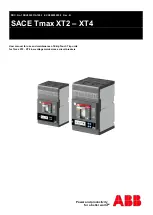
PART 6
OVERCURRENT TRIP DEVICES
GENERAL DESCRIPTION
The
direct acting series coils and magnet assemblies pro-
vide the energy to operate the over-current time delay
device and to trip the circuit breaker, interrupting sustain-
ed
and faults. There
(7) different
coils covering the range from 15 to 1600 amperes.
Each
is
and calibrated in the factory at the
desired continuous current rating. Any one of the seven
series coils
be used in any of the
circuit breakers
and FM Fusematic circuit breakers
the
rating dues not exceed the maximum continuous current
rating of the circuit breaker frame. [IE.,
Dual Magnetic
Overcurrent Trip Device
(Figure 18)
The dual magnetic
device, in combination
with the series coil and magnet, provides inverse long de-
layed tripping for
below the instantaneous
pickup setting, and adjustable instantaneous tripping.
devices are factory calibrated and
be field adjusted.
Selective Overcurrent Trip Device
(Fig. 18)
The selective
trip device, in combination with
the series coil and dual
magnet, provides inverse
long delayed tripping for all
below the short
delay pickup setting, and short delayed tripping for all
and faults above the short delay pickup set-
ting.
devices
factory calibrated and can be field
adjusted.
Phasing Protection (Fig.
19)
When fuses are used to protect circuits feeding three phase
motors
similar reactive apparatus there is always the
possibility, upon the blowing of
fuse only, that the
apparatus, single phased, will bum out. To eliminate this
danger, Fusematic Air Circuit Breakers incorporate three
single phase trip coils, one in parallel with each of the three
main fuses.
The voltage drop
a blown fuse energizes the single
phase trip coil in parallel with it.
The trip coils will operate from 630 volts down to 24 volts.
Each coil, when energized, releases a spring loaded plunger
which trips and locks the circuit breaker in the “TRIP
FREE,” (Open) position. The plunger(s) which has been
released indicates which fuse(s) have blown. They are
reset manually, after replacing the blown fuses, by pulling
the plunger(s) out as far as they will go and releasing
them. The reset plunger will remain latched in the “OUT”
position. The circuit breaker should be thoroughly in-
spected after every “Blown Fuse” operation and returned
to service only after the conditions in part 3 Section 1
II “Inspection and Installation” have been satisfied.
OF OPERATION
A.
Series Coil and Magnet
The current through the series coil provides the
motive force to energize the magnet assembly. The clapper
type
exerts force on the push rod which
operates the trip unit and trips the circuit breaker. The
current rating of the
and magnet may he changed by
moving the pole
assembly up
down. The trip
system must
recalibrated after adjusting the magnet
face.
B. Dual Magnetic Overcurrent Trip Device
(TD-1)
(Long Time Delay and Instantaneous Trip)
The
delay
trip device
of
dash
which
by the positive displacement of liquid
and
adjustable tension coupling
spring which permits the push md to
rapidly when
the force
the magnet exceeds predetermined value.
The lever ratio between the push
and the dash pot is
adjustable permitting the time delay to be varied. There
three adjustment bands, identified
minimum, inter.
mediate and maximum. In addition to the long delay band
adjustment there is a” adjustable tension spring which
prevents motion of the push rod for currents below the
maximum desired continuous current. This is the long
delay pickup. It is adjustable from 80 percent to 160
percent with calibrated points at
and 160%.


























